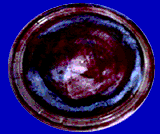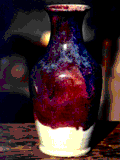

More Pages
-
 <- Go to Back to Index Page ->
Index of all Pages
<- Go to Back to Index Page ->
Index of all Pages
 <- Go to Directory of Categories Page ->
Directory of Categories Page
<- Go to Directory of Categories Page ->
Directory of Categories Page
 Go to the Ceramics Directory ->
The index of Ceramic Pages
Go to the Ceramics Directory ->
The index of Ceramic Pages
 Go to Using Bottle Glass Page->
Using Bottle Glass in the glaze
Go to Using Bottle Glass Page->
Using Bottle Glass in the glaze
 Go To Making Teapots Page ->
Article on Making Functional Teapots
Go To Making Teapots Page ->
Article on Making Functional Teapots
Copper Red Glazes
Oxblood Glazes or Copper Red Glazes above Cone 10
Before we discuss the problems associated with the Oxblood Glazes, we should first understand the dynamic of color and how we see color in a glaze. There are rods and cones within the eye which see the ifferent wave length of light as it comes into the eye and bounces off of the Optic nerve. There are a number of individuals who can not see an Oxblood Glaze because they do not possess the rods to see a Red wave length of light particles. So in fact some of us may not be able to see the Oxblood Glazesat all.
The particles of light, called photons, are reflected off the Cupric Ion crystals in the glaze to produce a red wave length of light. In order to do this, first there must be enough copper present in the Glaze to produce the alpha Ions of Cupic oxide that light must refract off of in the red wave length. This may seem simple enough by just adding a sufficient supply of Copper to a glaze to produce the amount of Cupric Ion necessary for the reaction to take place. Unfortunately, it is not that simple. Copper has a low boiling point within the Silicate Solution that we produce to make a glass for our ions to reflect the light off of. The Copper will normally boil out of the glaze and not be present at the end of the firing cycle when heated to temperatures above Cone 9 . Indeed the best Oxblood Glaze that I have produced are Cone 12 to Cone 14 glazes and I will discuss how to keep the copper Ions from boiling out of the Glaze. By adding Iron and Boron to the glaze, we can keep the Copper Ions from boiling out of the glaze. So we make sure that our glaze has a supply of Iron and Boron to cling to and not boil out. I use about 1 %Red Iron Oxide to promote the Copper from boiling out of the glaze. I use a combination of Gerstely Borate and Borax as a substitute for Colemanite. Borax sends to dissolve into the water and form a soapy film on the pots. It still has additions that make it better than Gerstely Borate alone.
The next problem we face with the Oxblood Glaze is that the Copper and the Boron acts as flux to the Glaze and may run off the pot. We must stiffen the glaze with a sufficient proportional amount of Silica in the glaze to make it a stiff Glaze that will not run off the pot. In addition, I use this Oxblood over another stiffer glaze that will catch the running Oxblood. My Clear Boron Crackle Glaze is such a glaze.
The Oxblood Glazes also need to have the free Oxygen molecule removed from them so that they will become Cu++ ions and form the Ionic crystals that will refract the photon into a red wave length. There are two methods to achieve the desired affect. The first is to starve the kiln for Oxygen when the kiln has reached a temperature where the glazes are molten. I bring the kiln up to Cone 10 and then starve it for Oxygen by restricting the flow of gases from the kiln and cutting back the flow of Oxygen to the burners to produce a yellow flame that seeks Oxygen from the glazes. In addition, I include in the glaze a local reducing agent in the form of FFF silicon carbide to help in the reduction process. This must be mixed well with the glaze because it settles out. I stir and mix up continually when I apply this glaze. I use an additional emulsifying agent in the glaze to help keep material in suspension in the form of Bentonite and the form of Epsom Salts. The Epsom Salts make the glaze smell like rotten eggs after a few days and when I am not using this glaze, I cover it or keep it in a jar.
The next problem that Copper Red glazes present is that because they are releasing Oxygen, they can have lots of pin holes in their surface. We need to add several ingredient that will degassify the glaze and minimize this effect. I add Calcium to the Glaze in the form of Whitting (CaCO3 ) and the form of Bone Ash or technically Calcium triphosphates (Ca 3Ph CaCO3 ) . These ingredient will flux the glaze as well and also cause the Copper to boil out of the Glaze, so a balance must be achieved between these ingredients and the materials promoting Copper Ions forming into the crystals that refract the light into a red wave length. In addition, I let the kiln sit at a lowered flame at the end of the firing cycle to allow the glaze to release the oxygen molecules from the glaze and heal the pitting over.
Finally, the red color shows best upon the white clays of porcelain rather than that of the brown stoneware. Porcelain has its own problems to work with as well. The fine Porcelain clay is harder to throw clean forms out of in uniformly thin walled pots. The surface of the pots made of porcelain become loose and cause the glaze to crack off and pull away from the surface of the pot creating a crawling effect. Great care must be taken to Glaze thinly and apply coats of glaze and smooth them onto the surface of the pot. A gum arabic solution added to the glaze will help stop crawling.
With all the problems associated with the Oxblood Glazes, we can still see the results of our work when we get beautiful red pots with a minimum of flaws to crawling, pitting, and running. These are truly magnificent glazes which enhance our work. I tend to use several other glazes with the Oxblood Glaze to give a mottled effect and ensure that there is some benefit for my efforts.
I find that using the Oxblood to enhance a pot far more effective than using it exclusively.
Russell Andavall
The FireGod
Russell Andavall
andavall@pacbell.net
c/o West Coast Macaroni Factory
#4 1250 57th Ave
Oakland, Ca 94521
United States
You are the